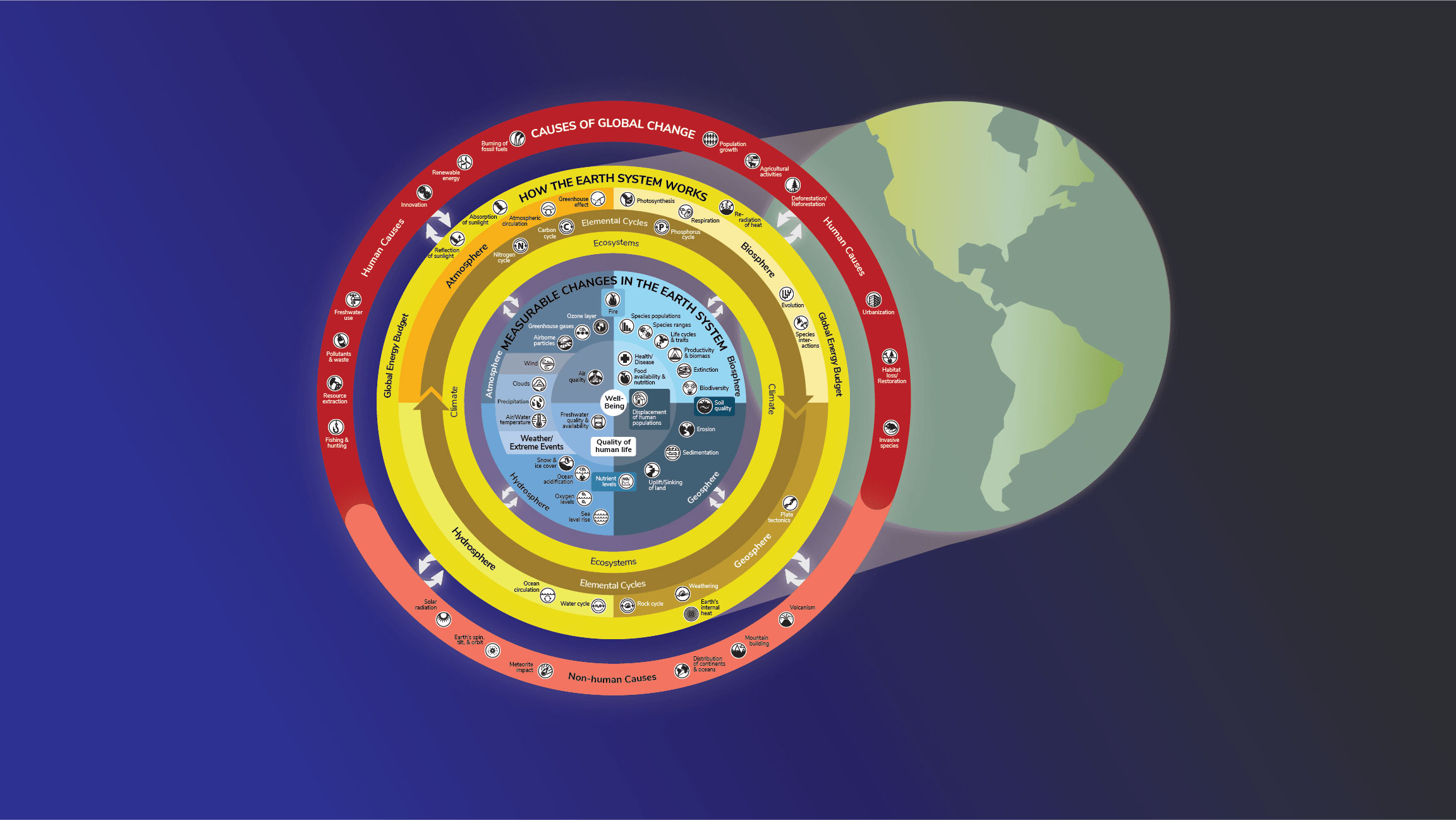In UGC 101 - Part 1, you were introduced to the processes that are essential to How the Earth System Works. To understand global change, we will turn our attention to the non-human and human phenomena that influence the Earth system, and explore what we can measure to determine how fast (rate) and how much (magnitude) the Earth is changing. First we will examine the non-human causes of change.
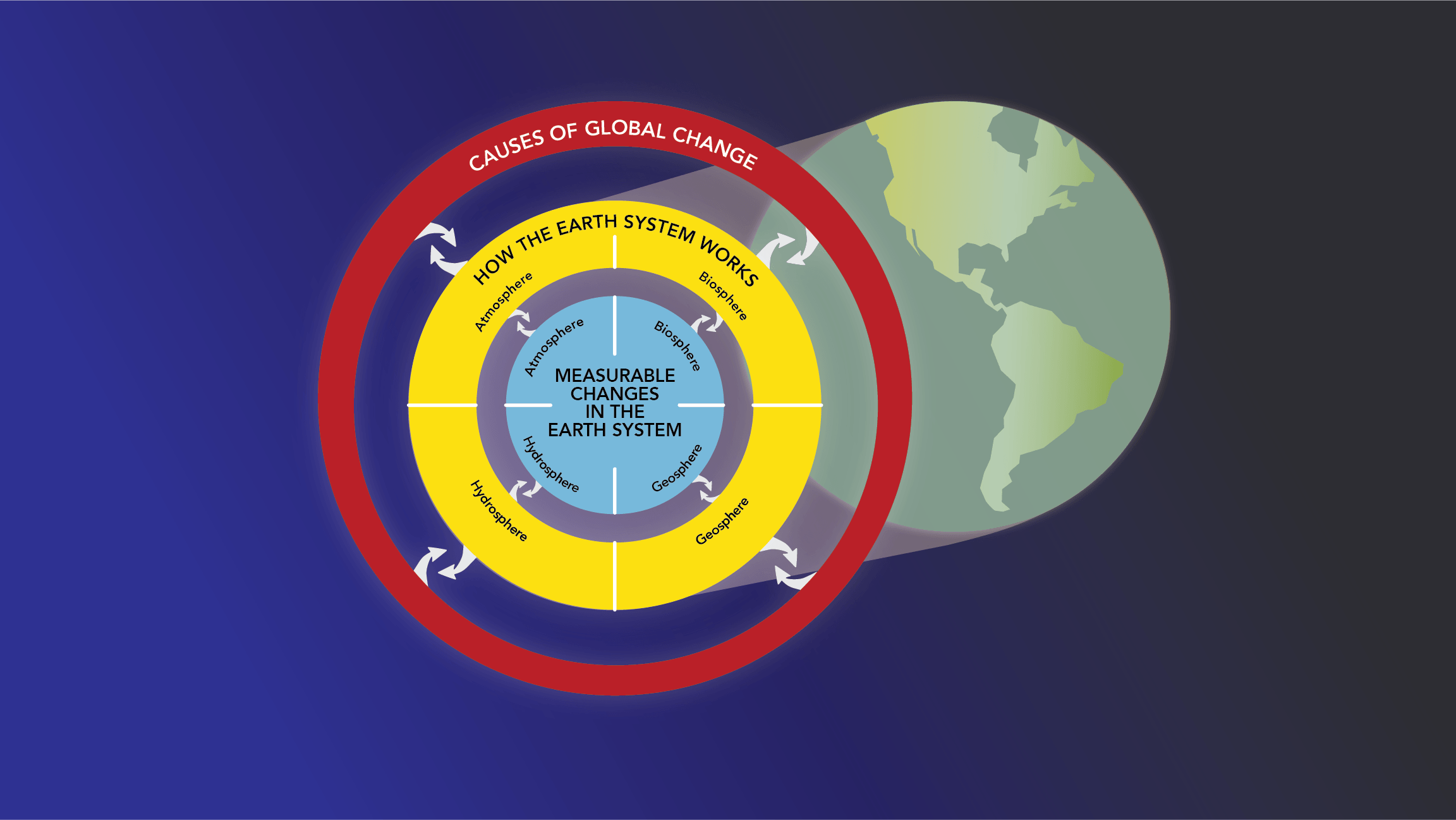
Some of the non-human causes of change, such as variation in Earth’s spin, tilt, and orbit, or changes in the distribution of continents and oceans, cause changes on timescales of tens of thousands to millions of years, and do not explain the rapid global changes we are observing today. Events that cause rapid change, such as meteorite impacts and major volcanic eruptions are rare, but when they do happen they can have catastrophic consequences throughout the Earth system. Here, we briefly explain some of these non-human causes of change. More information is available on the Causes of Global Change page.
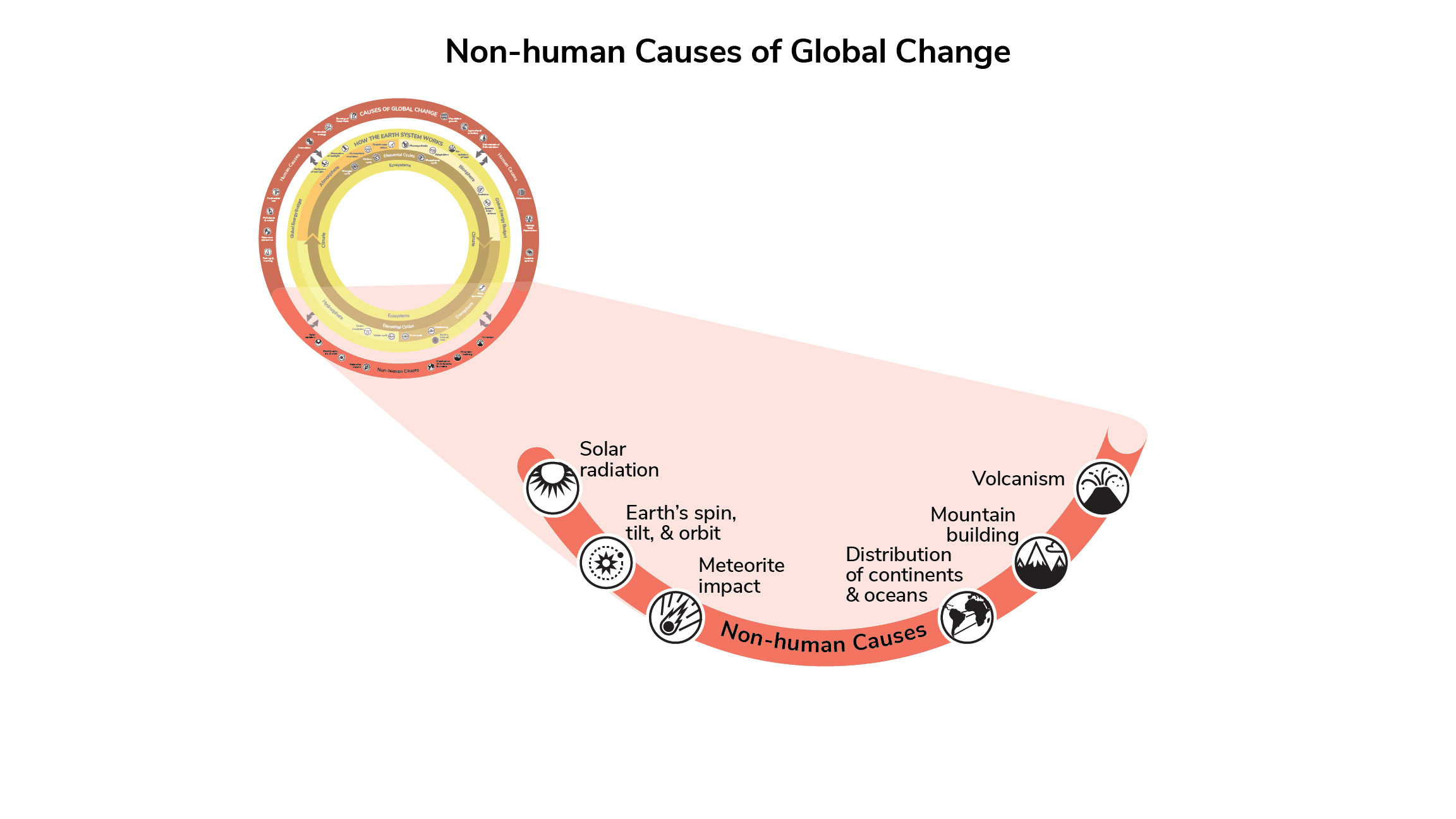
As the Earth orbits the Sun, the Earth is pulled by the gravitational forces of the Sun, Moon, and large planets in the solar system, primarily Jupiter and Saturn. These gravitational forces slowly alter the Earth’s orbit between a more circular and more elliptical shape over periods of 100,000 and 413,000 years, as indicated by the blue and yellow dashed ovals in the diagram below. Additionally, the direction of the Earth’s axis rotates (wobbles) over periods of 19,000 to 24,000 years. Further, the angle of tilt of the Earth's axis changes with a period of 41,000 years. These small changes alter the amount of sunlight received by different parts of the Earth over time, changing the length and intensity of the seasons. Over the last 800,000 years, changes in Earth's orbit caused cycles of ice ages approximately every 100,000 years. The Earth’s spin, tilt, and orbit continue to change today, but do not explain the current rapid climate changes.
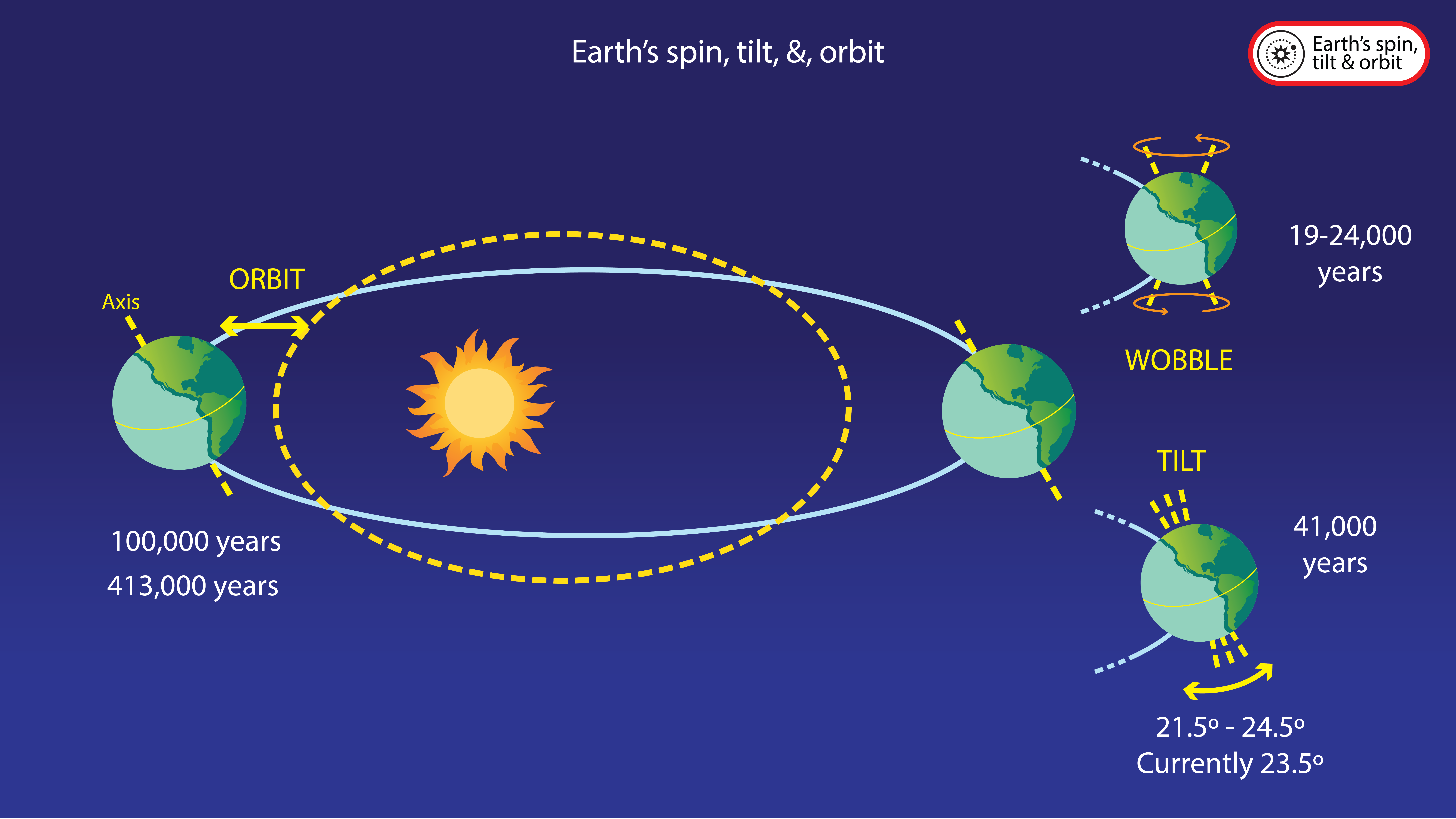
Continents move and oceans open and close over 10s to 100s of millions of years because of plate tectonics. Plates typically only move around 2-10 cm/year, but over millions of years this motion alters the size, shape, and depth of ocean basins and the distribution of land masses. The location of oceans and continents, including mountains, influences how heat is transported by ocean and atmospheric circulation and where ice accumulates on land, which in turn shapes climate, biomes, and ecosystems.
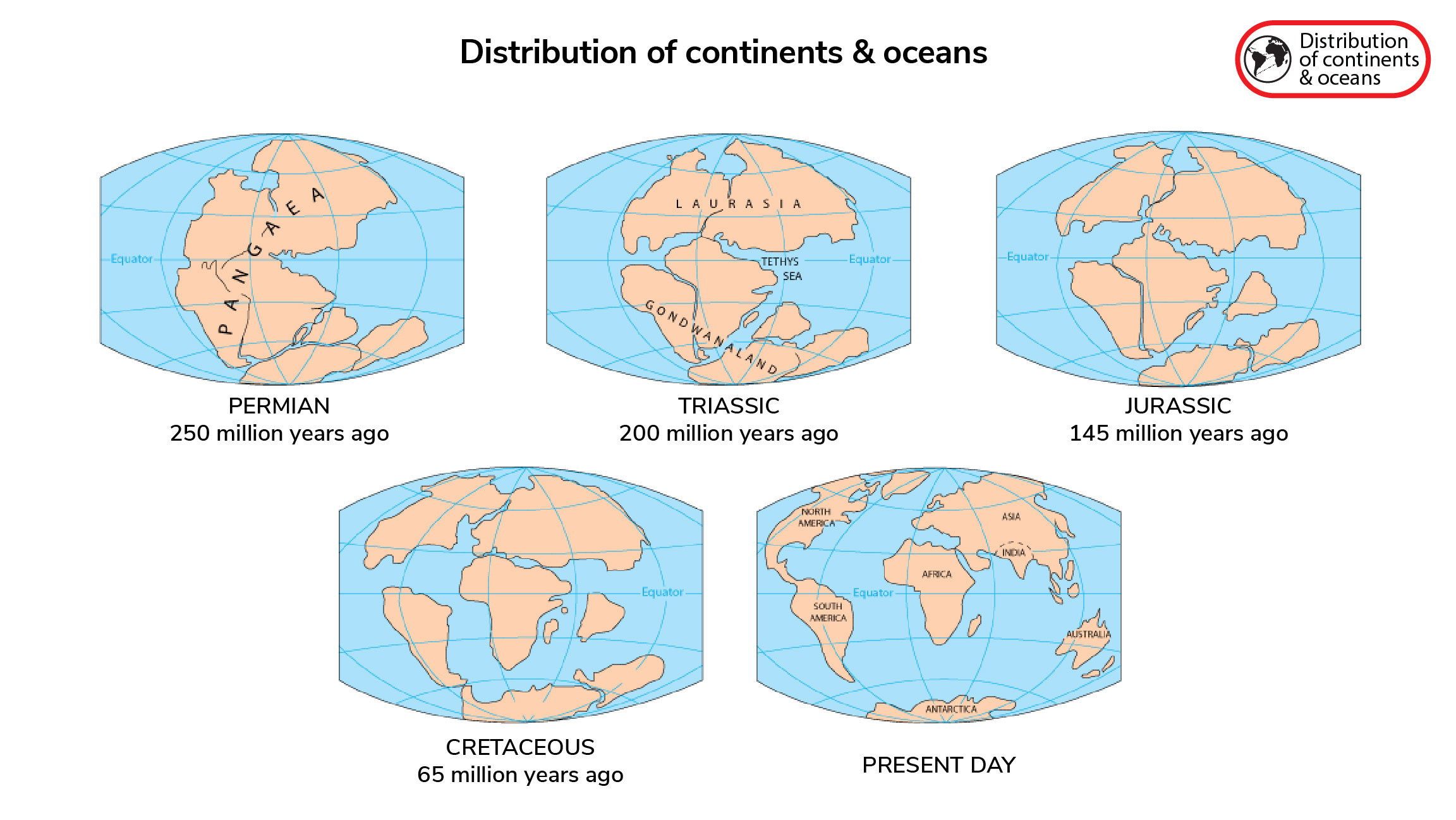
Slight fluctuations in the amount of energy released by the Sun have been measured for more than 40 years. These fluctuations include increases and decreases that occur approximately every nine to eleven years, shown by the red line on the bottom graph, which correlate with the number of sunspots on the surface of the Sun. However, this pattern of solar output does not match the overall increase in global average temperatures observed over the same time period (blue line in top graph), leading to the conclusion that change in solar radiation is not a cause of the Earth’s rising average temperatures.
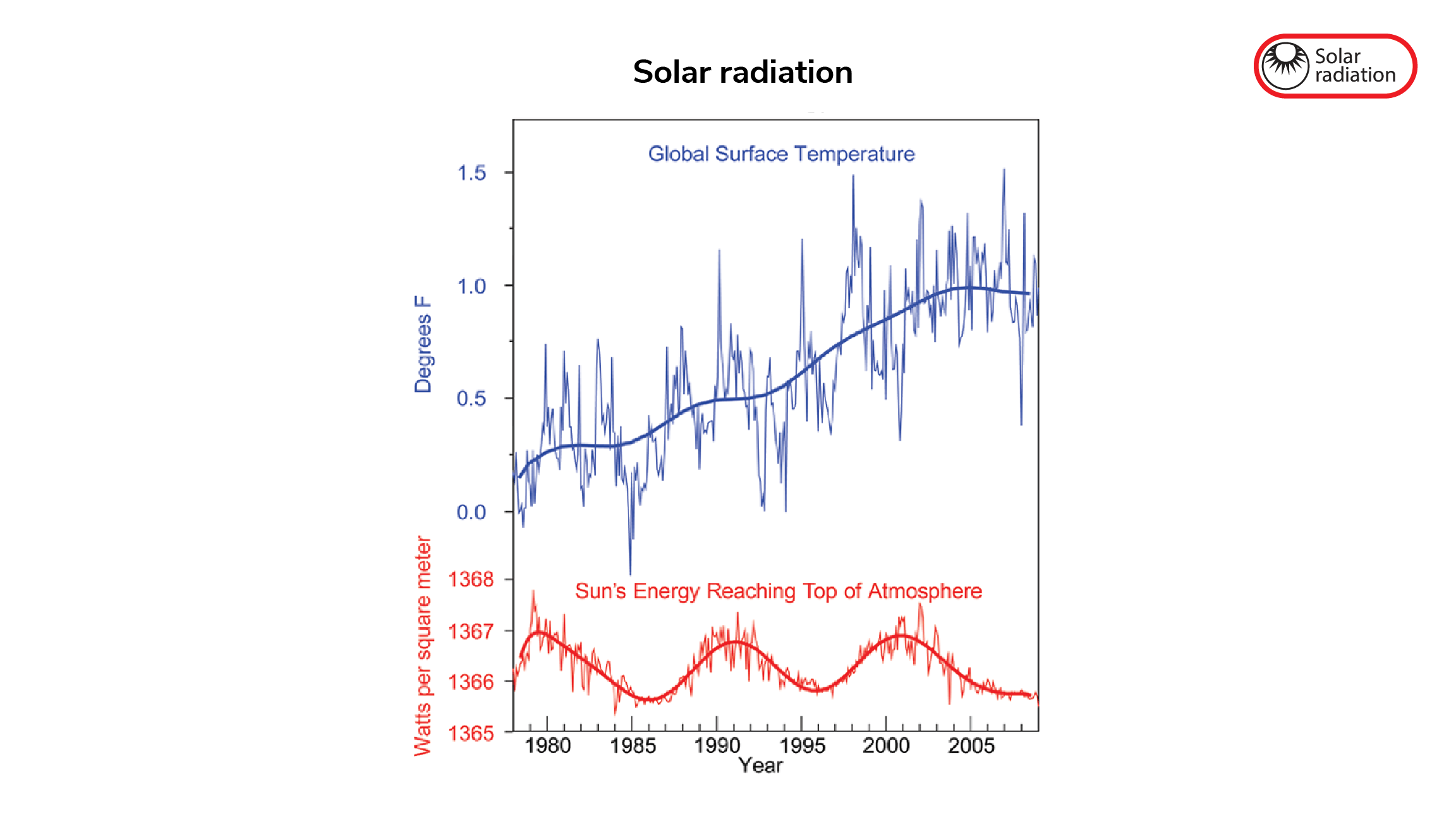
Having briefly surveyed the non-human causes, we will now examine some of the human causes of change, which are necessary for understanding how the Earth system has changed over the last century.
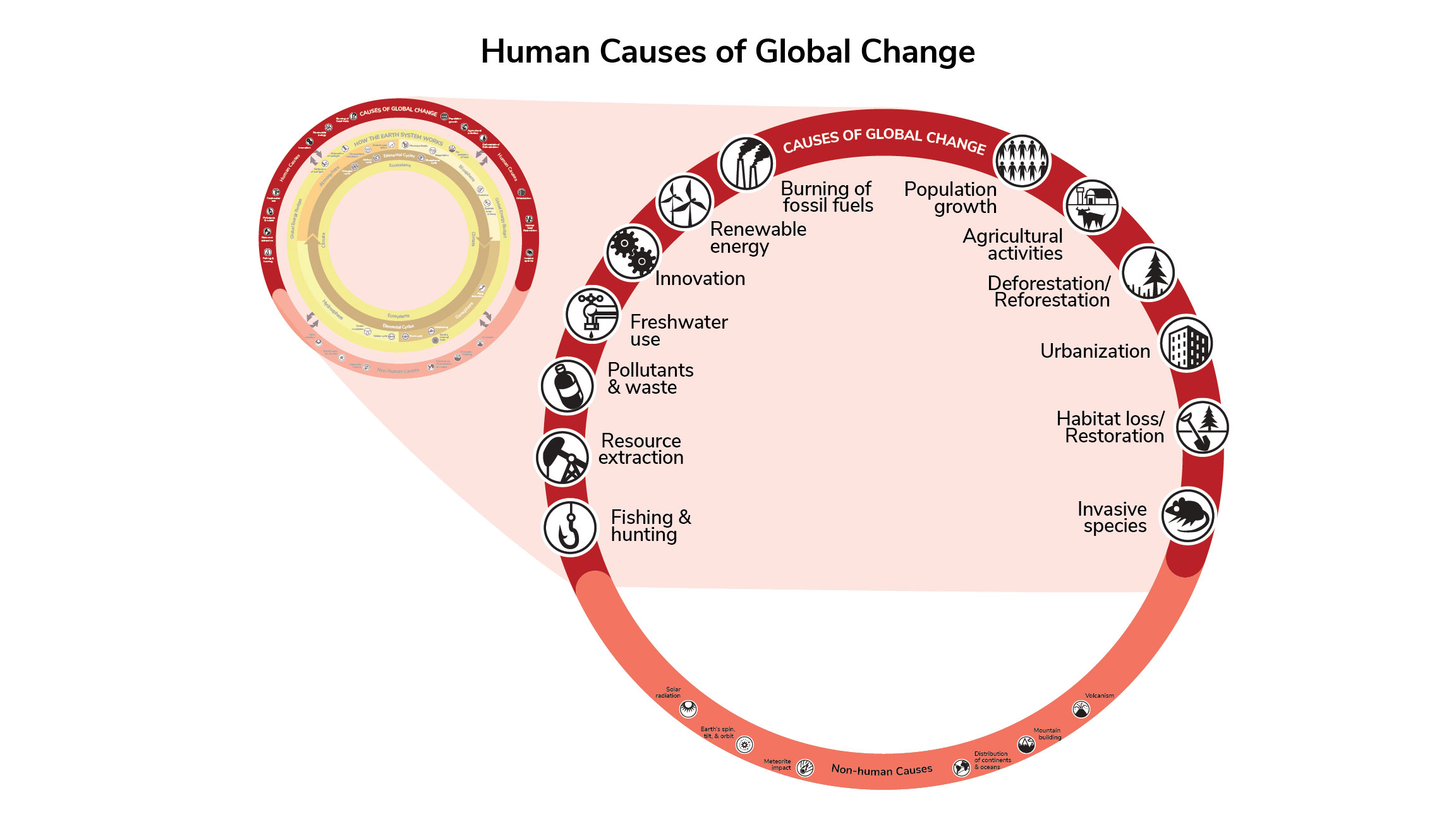
Humans, especially over the last century, have dramatically changed the Earth system by extracting and using Earth’s resources to power and sustain modern life. Fossil fuels have been our primary source of energy, which increases greenhouse gases in our atmosphere. Use of fossil fuels is the primary cause of climate change today. Resource extraction and the burning of fossil fuels also release pollutants and waste that contaminate the environment and are harmful to life. Sustaining modern life, through our industrial and agricultural activities, also requires large amounts of freshwater, which we extract from the ground and divert from rivers and streams.
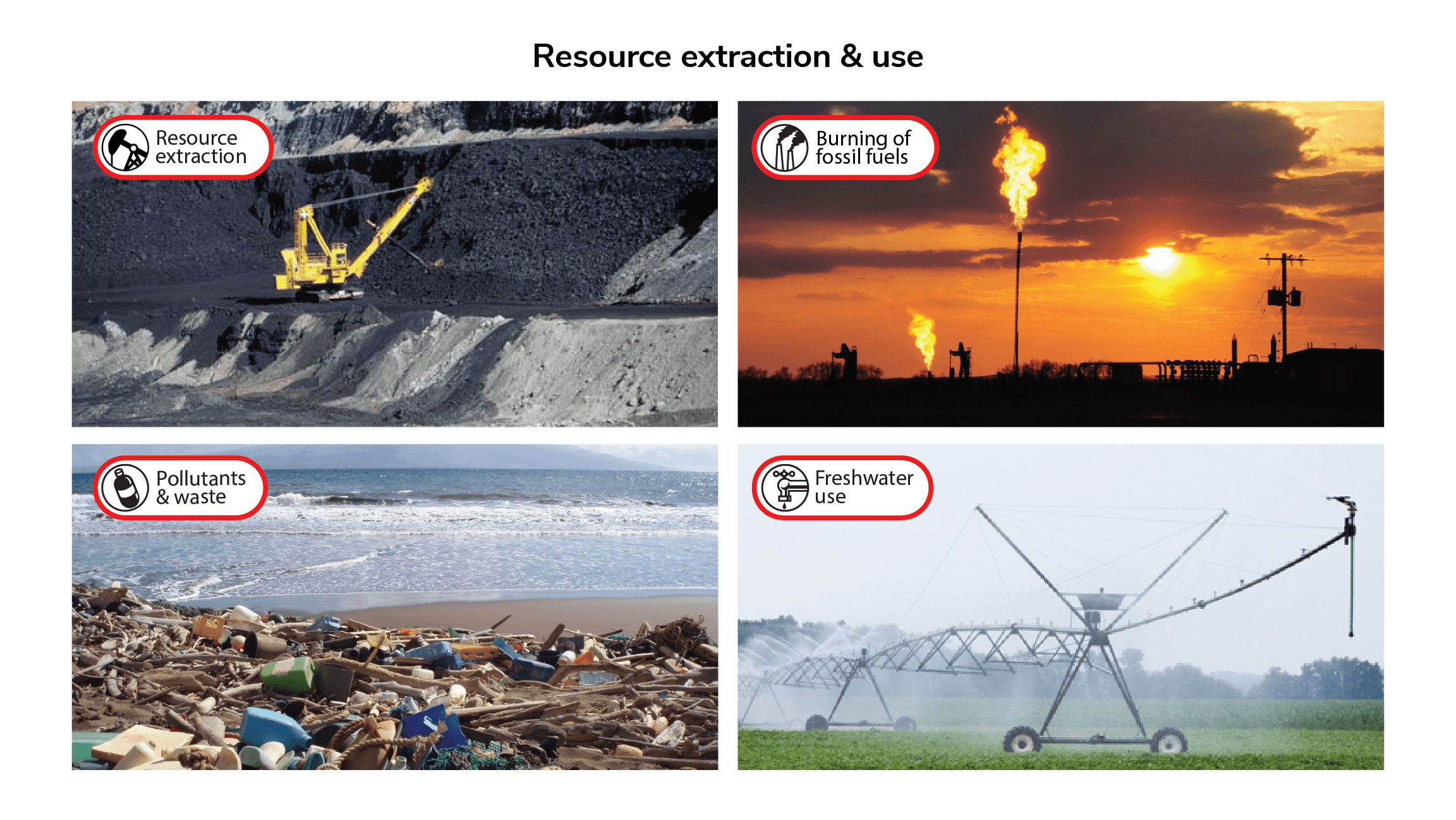
Humans have dramatically reshaped the surface of the Earth. We have removed forests, and plowed and paved more than half of Earth’s land. Over the last century, these activities have been enabled by technologies we power with fossil fuels. Humans continue to disrupt ecosystems to expand urban areas and farmland. Unfortunately, many farming practices introduce pollutants to surrounding ecosystems and do not sustain soils for long-term use.
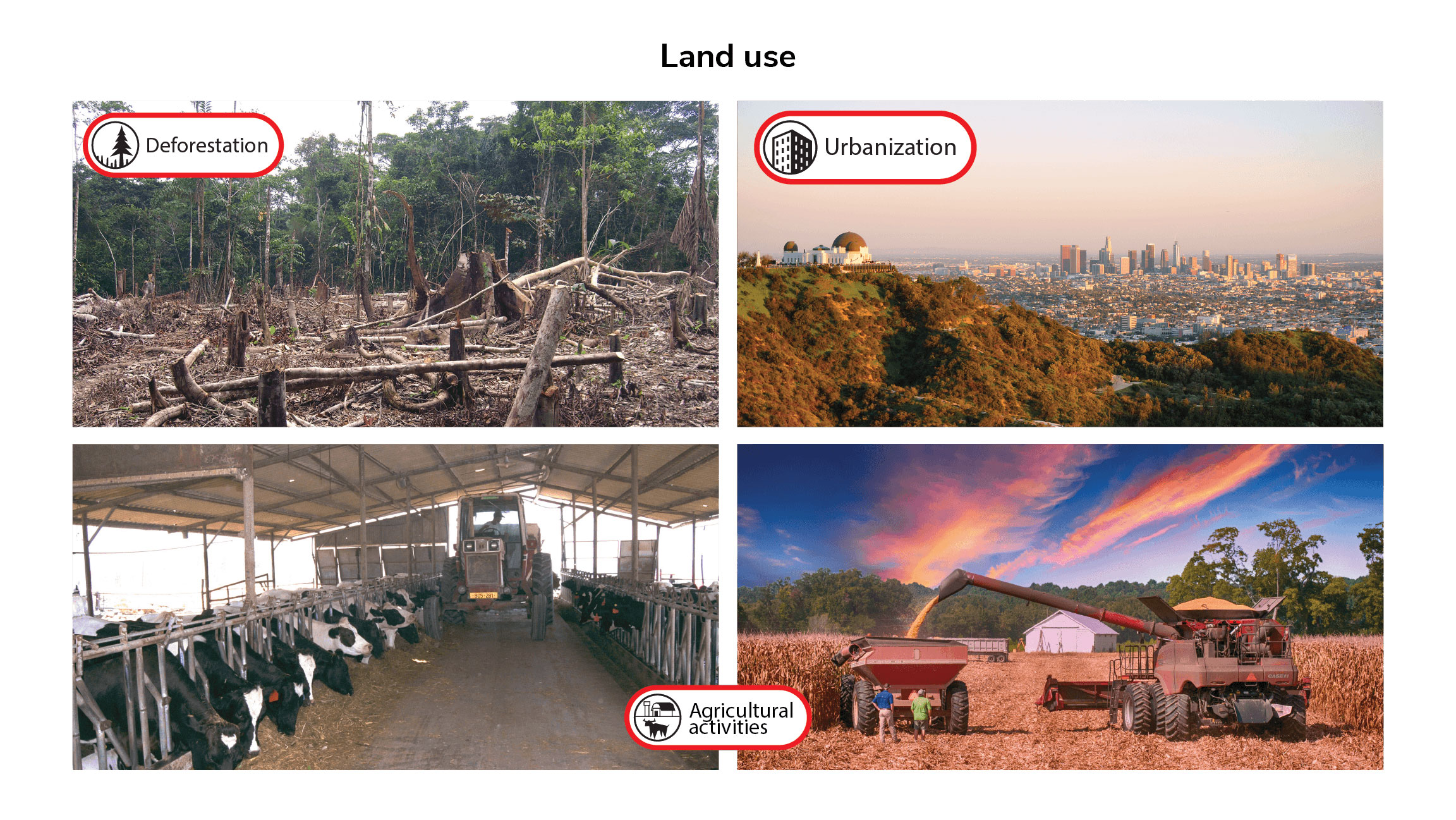
As we recognize how we are changing the Earth, we can also develop technology and solutions that can sustain human life and ecosystems. Our ability to innovate will hopefully allow humans to mitigate climate change, and be resilient in a changing world. Restoring habitats, such as coastal environments, can benefit human populations by buffering cities from rising sea levels. Forests can absorb greenhouse gases through photosynthesis and provide a sustainable source of resources. Innovations in renewable energy, such as solar and wind power, can provide energy we need for modern life without contributing to global warming.
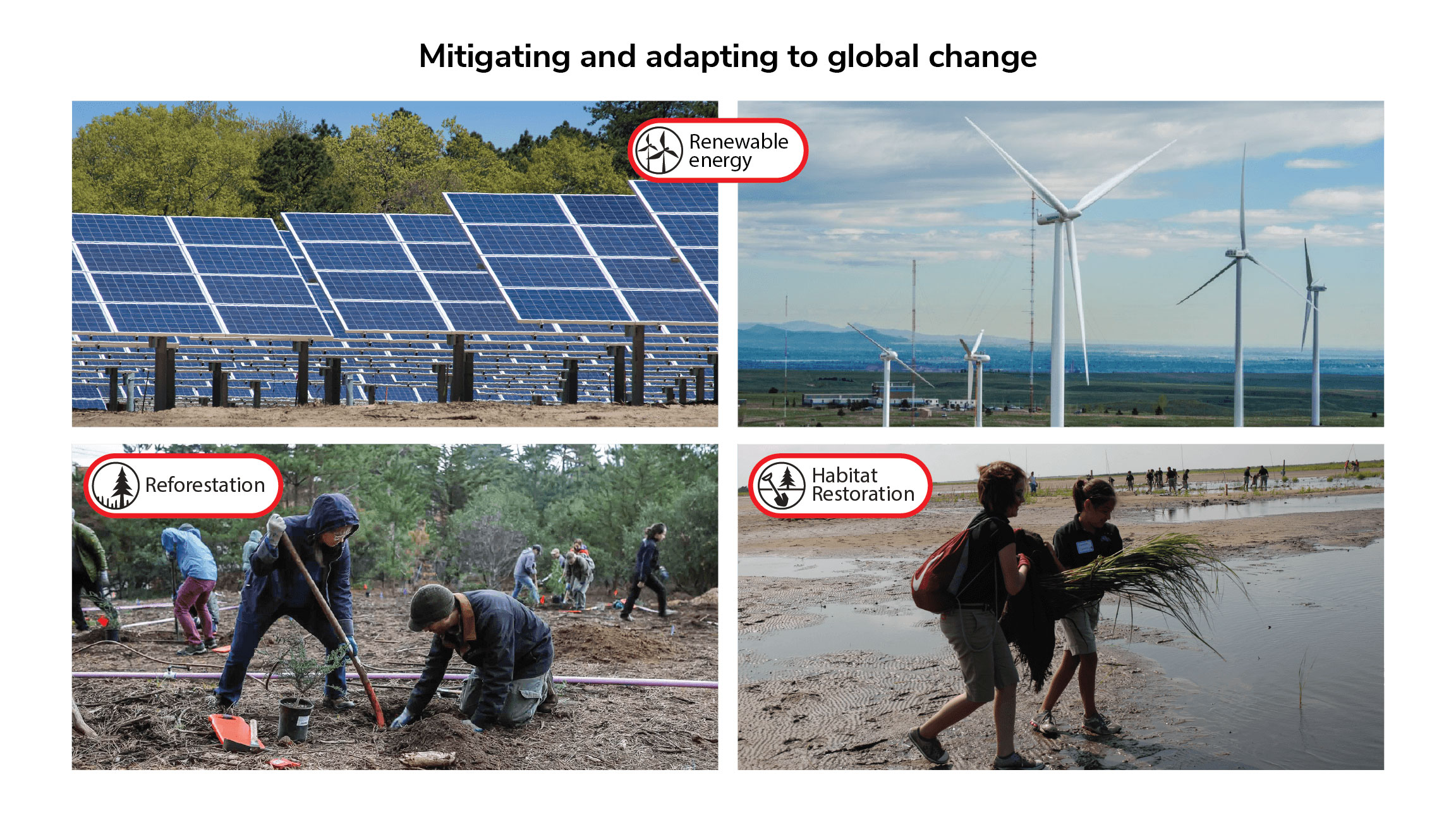
For most of human history, our population size was relatively stable. But with innovation and industrialization, our energy, food, water, and medical care became more available and reliable. Consequently, the global human population rapidly increased, and continues to do so, dramatically impacting global climate and ecosystems. We will need technological and social innovation to help us support the world’s populations as we adapt to and mitigate climate and environmental changes.
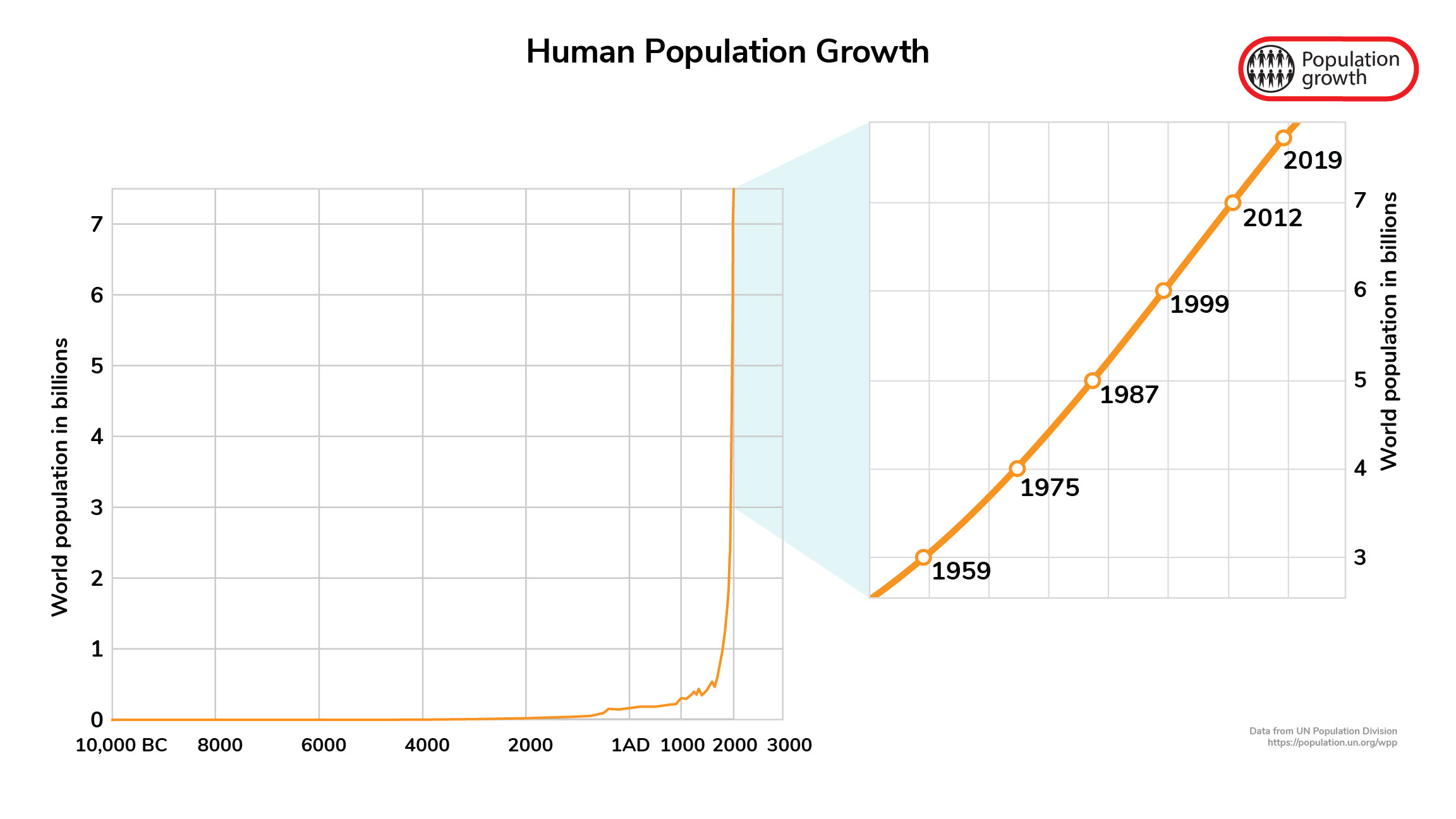
You have now been introduced to some of the major Causes of Global Change. We will now explore parts of the Earth system that we can measure over time to determine how fast (rate) and how much (magnitude) the Earth system has changed. In the Understanding Global Change Framework, Measurable Changes are placed in the middle of the diagram, shown in blue. Studying past global change is essential for understanding and making predictions about global change today, and will help us prepare for a sustainable future. There are an enormous number of aspects of the Earth system that can be measured. Here we will consider just some of the most significant changes that are occurring around the world.

The next few slides outline some of the Measurable Changes that occur in the atmosphere and hydrosphere. For example, we measure greenhouse gas levels and airborne particles in the atmosphere, and sea level rise and ocean acidification in the hydrosphere. Notice that in How the Earth System Works (the yellow ring), we talked about climate, but here we talk about phenomena we measure on an hourly and daily basis - temperature, precipitation, clouds, and wind - which we call weather. Some of these measurable changes in the atmosphere and hydrosphere will now be explained briefly. Explore the Measurable Changes in the Earth System page for more information about how these changes are connected to other processes and phenomena.
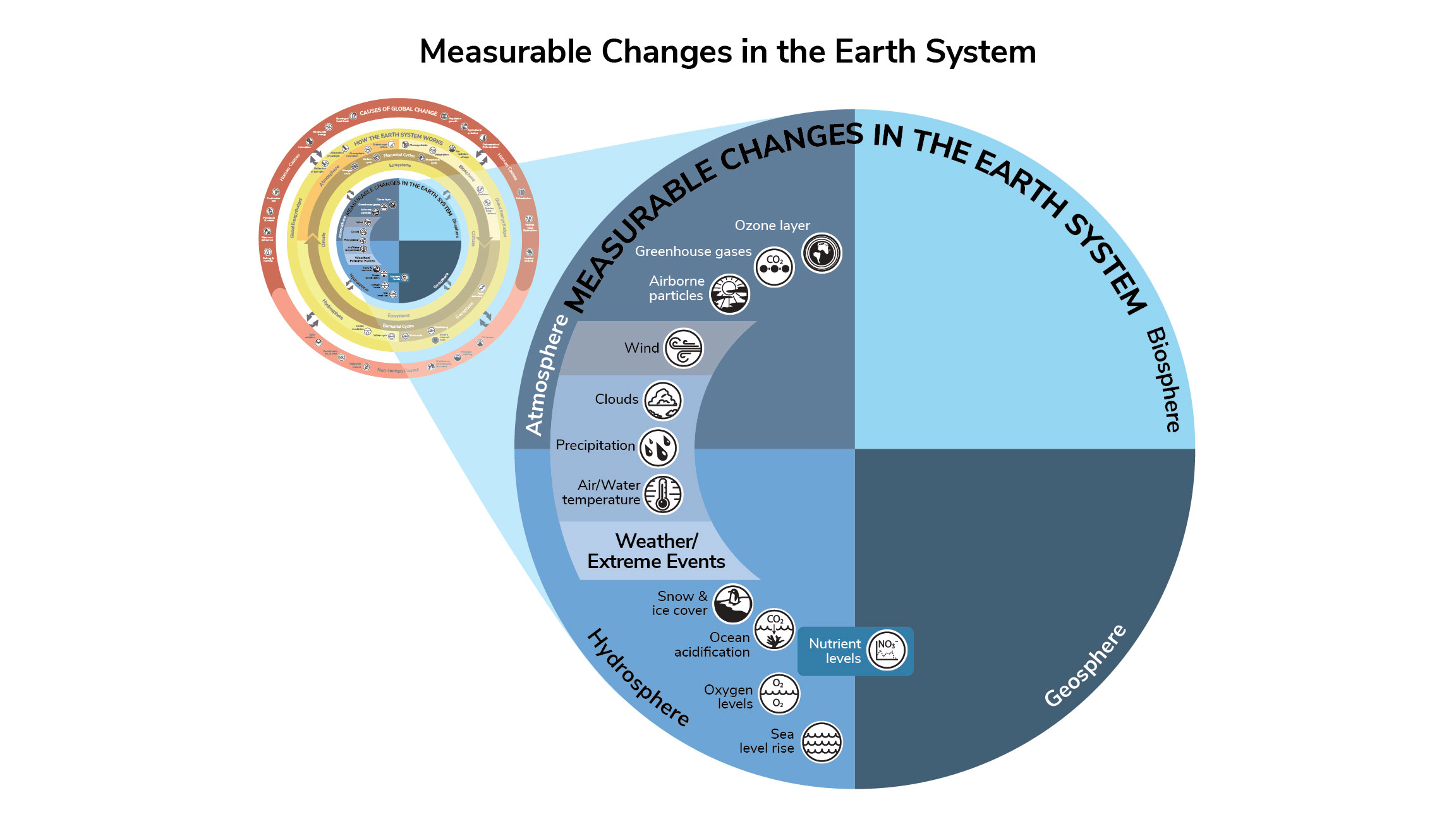
Around the beginning of the Industrial Revolution in the late 1750s, atmospheric carbon dioxide levels were at about 280 ppm (parts per million), and for the previous 800,000 years were not above 300 ppm. However, levels have increased to over 400 ppm due to human activities, including the burning of fossil fuels, agricultural activities, cement production, and deforestation. Humans (Homo sapiens) evolved around 300,000 years ago, so our species has never before lived in a world with carbon dioxide levels as high as they are today.
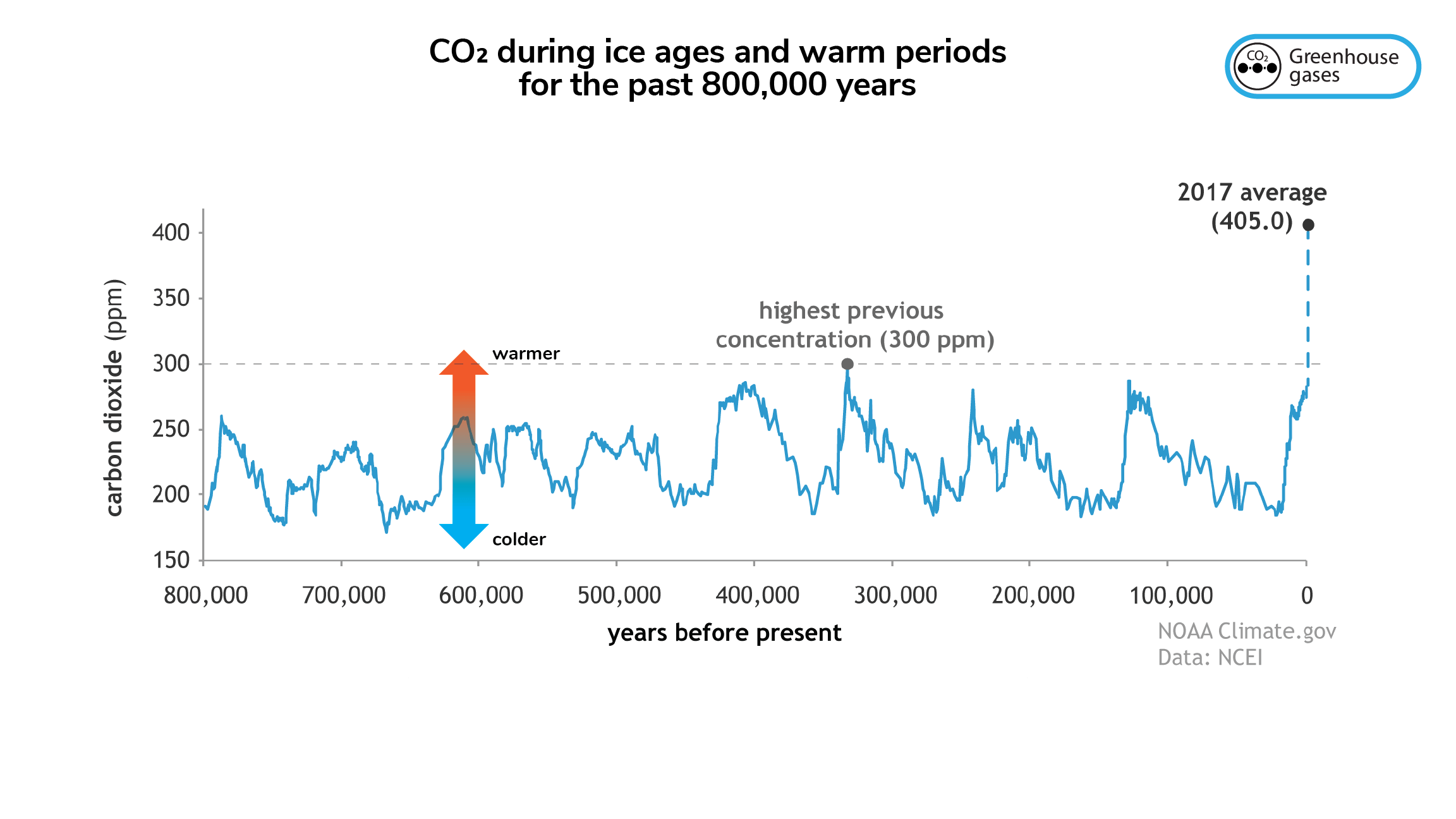
The increase in greenhouses gases in our atmosphere due to human activities has increased Earth’s average temperature, as seen below. This map compares global surface temperatures in 2017 to the 1981-2010 average temperatures. The red parts of the map indicate that the largest changes in temperature happened at high latitudes in the Northern Hemisphere, and that most of the planet is warming. Note that because heat is redistributed by atmospheric and ocean circulation patterns, slight cooling is observed in some regions.
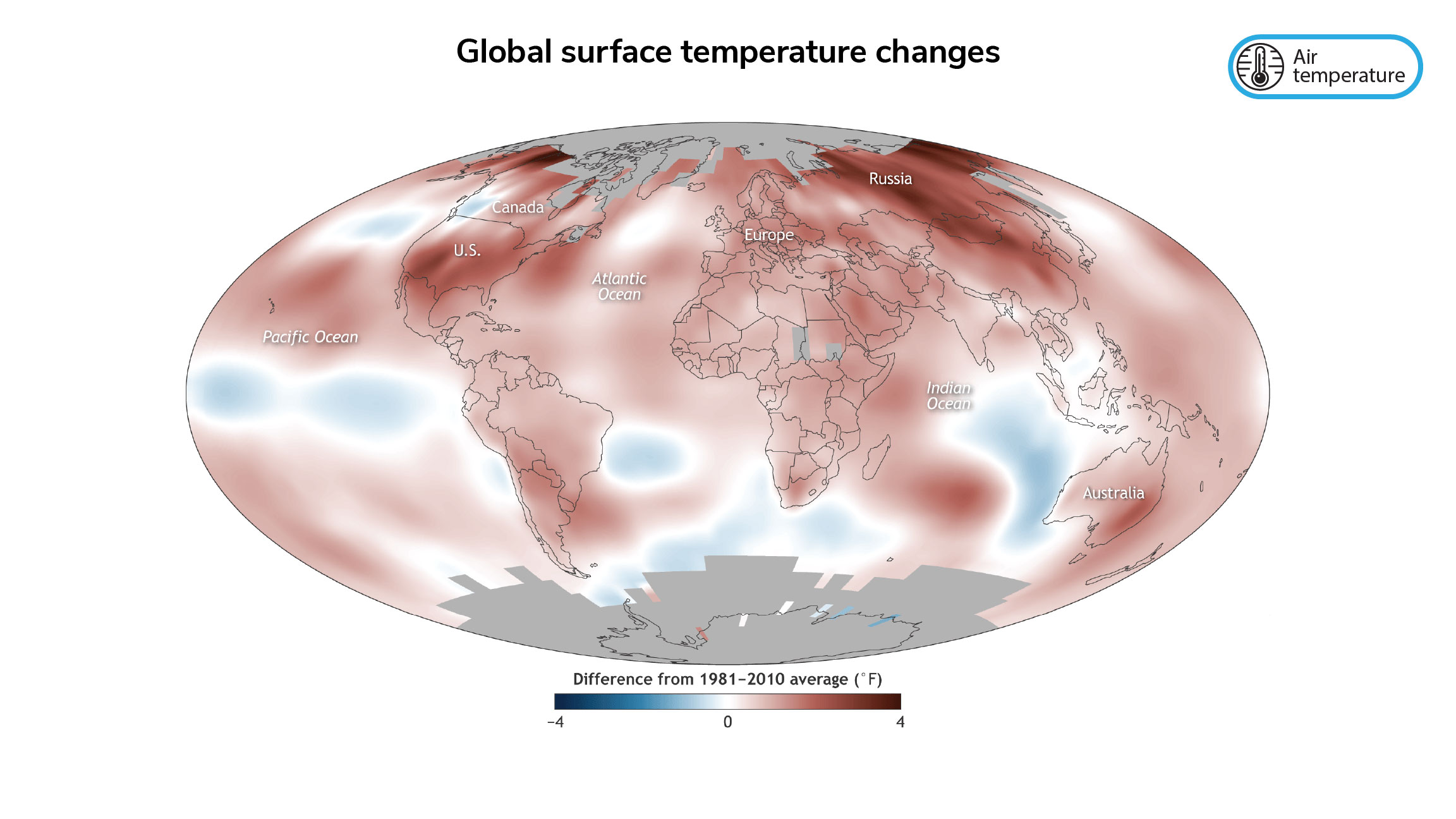
Scientists track how much sea ice has melted using satellites. As the world has warmed, sea ice has reduced dramatically, especially in the last 10 years, shown in the 2017 map below. The melting of sea ice and ice on land influence other global processes, such as ocean circulation and how much sunlight is reflected by Earth’s surface (albedo).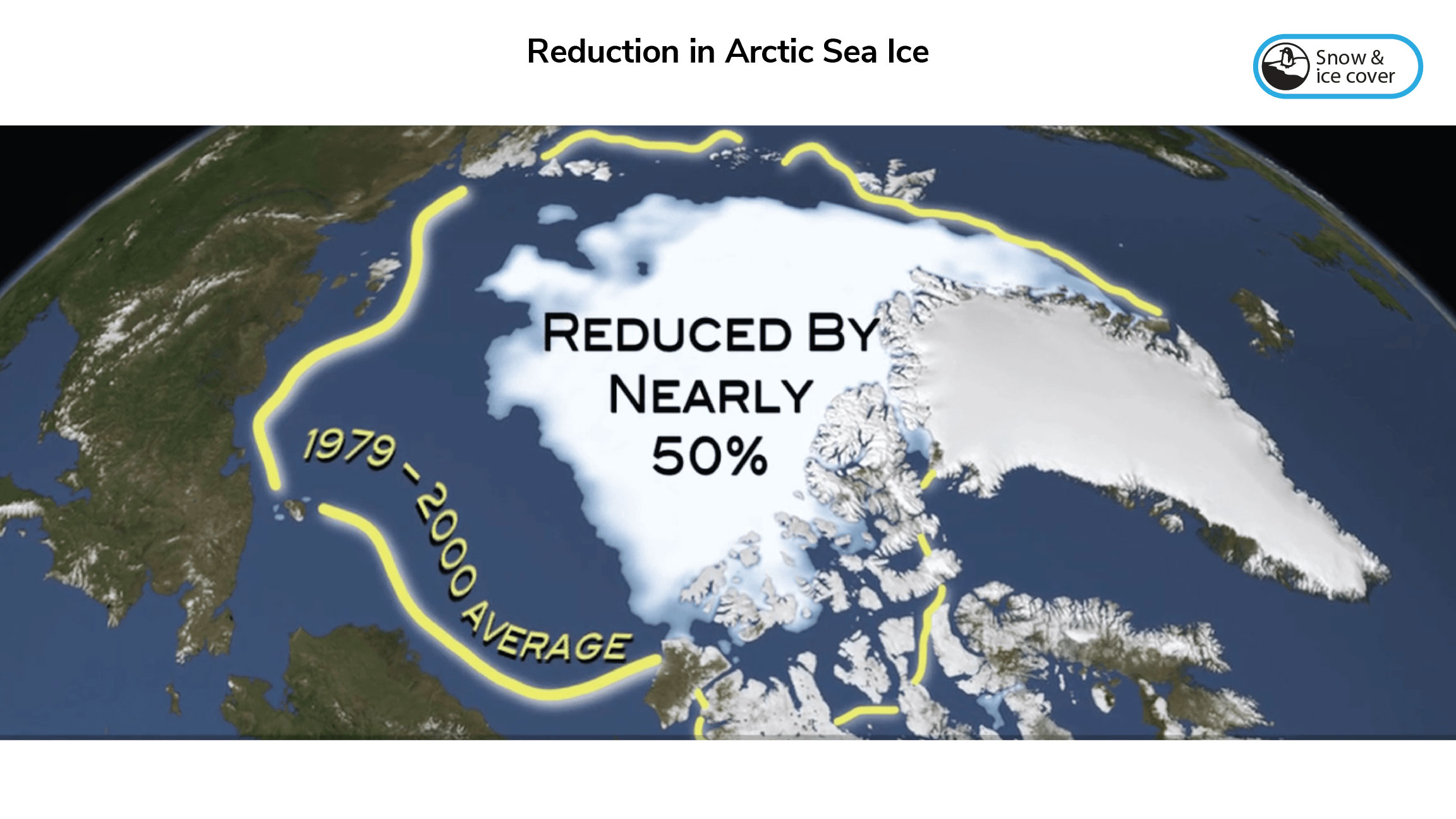
Sea level rise is due to water flowing into the ocean from melting land ice, and because of the overall warming of the world, which causes ocean water to expand (called thermal expansion). Around 40% of the global population lives in densely populated coastal regions, and many communities are already affected by rising sea levels.
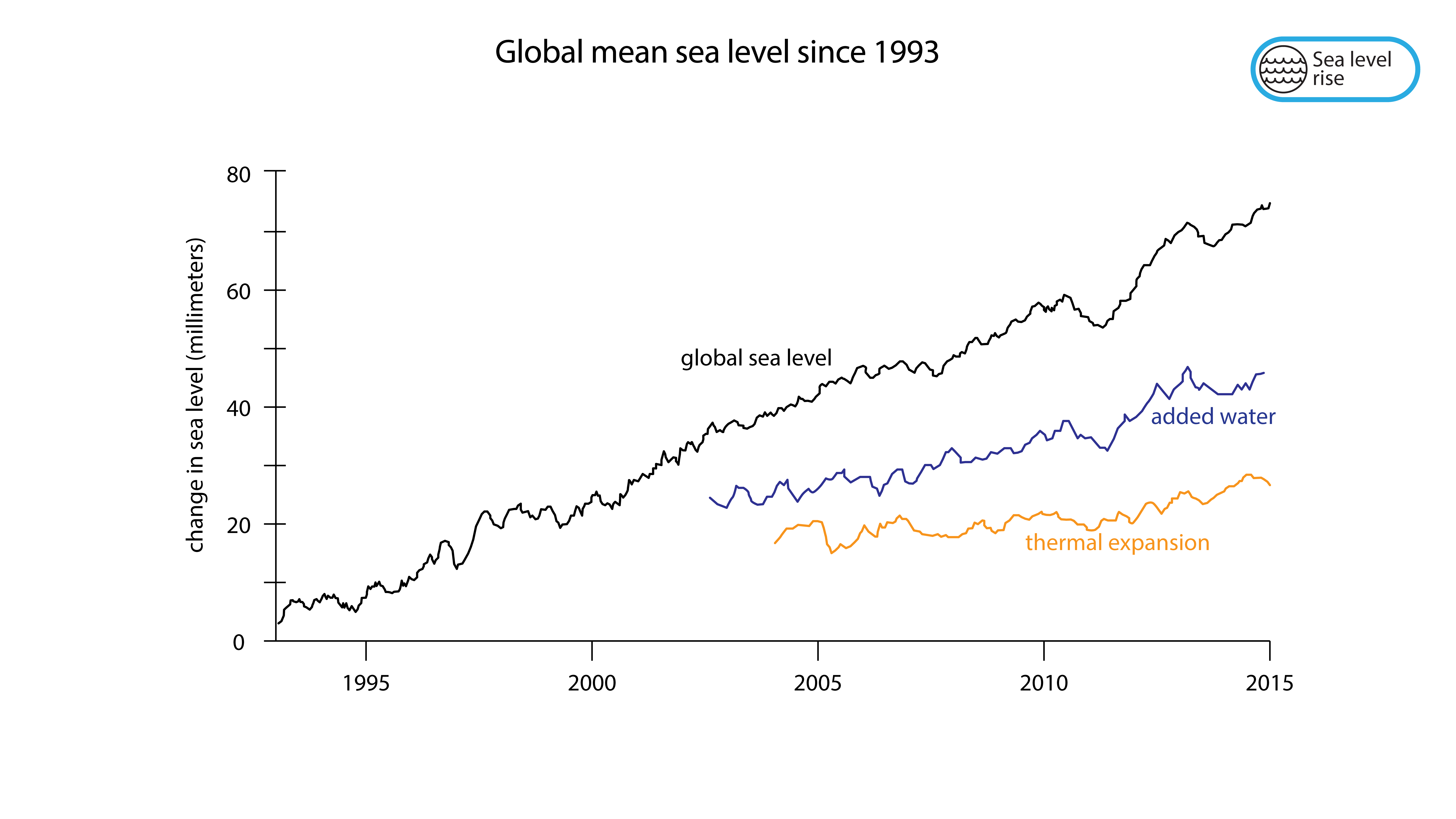
As human activities have increased carbon dioxide levels in our atmosphere (red line below), about a third of that carbon dioxide has been absorbed by the ocean (green line below). As this carbon dioxide dissolved into the ocean, the acidity of the ocean has increased (the pH has decreased, blue line). Changes in acidity can stress marine organisms, especially those that grow calcium carbonate shells or skeletons, making it more difficult for them to grow and survive. Ocean acidification impacts species populations and food webs, including organisms that are food sources for humans around the world.
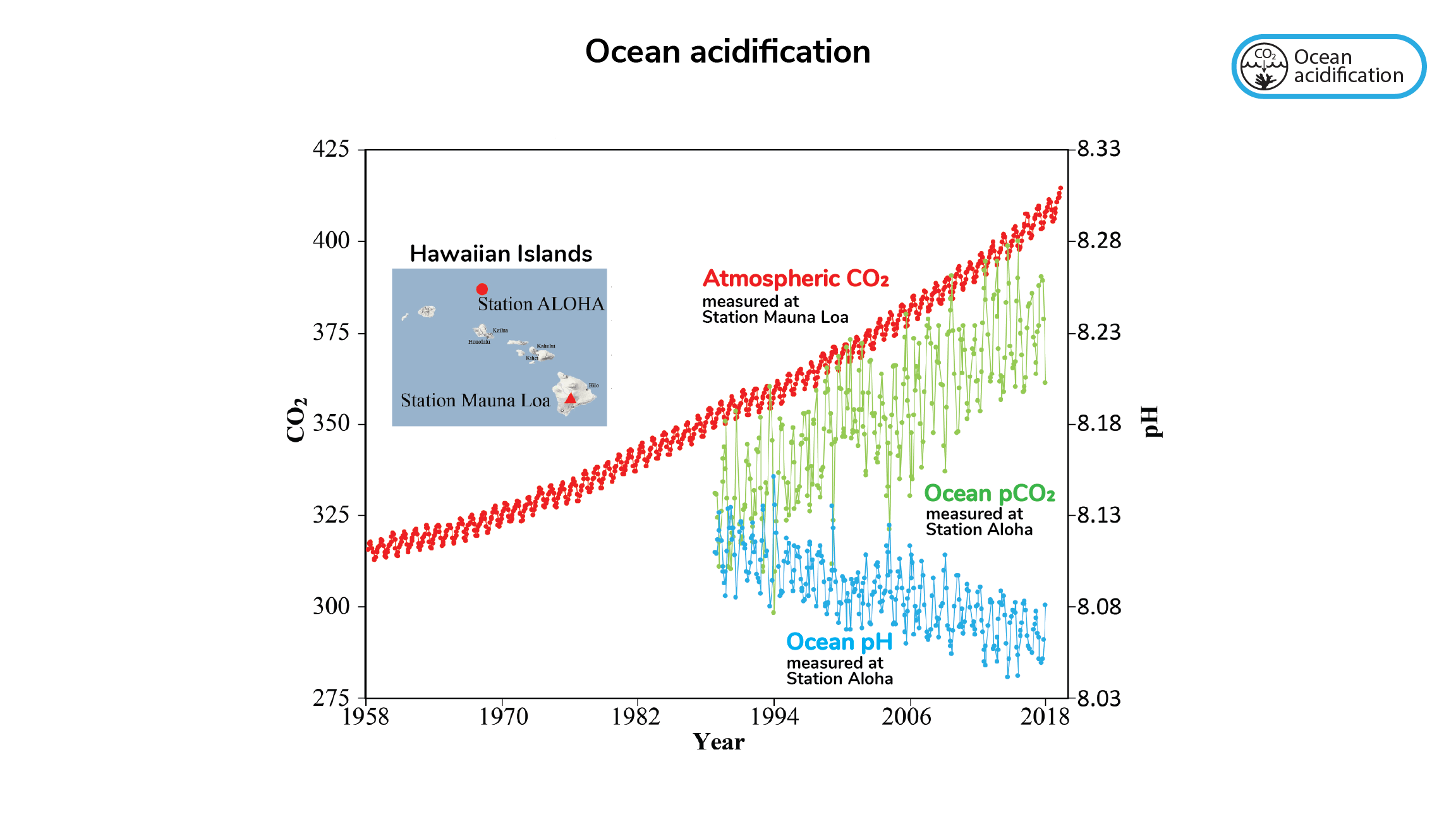
In the diagram below, we have now added icons representing Measurable Changes in the biosphere and geosphere. In the next two slides, we will briefly explain some of these changes. Explore the Measurable Changes in the Earth System page for more information about how these changes are connected to other processes and phenomena.
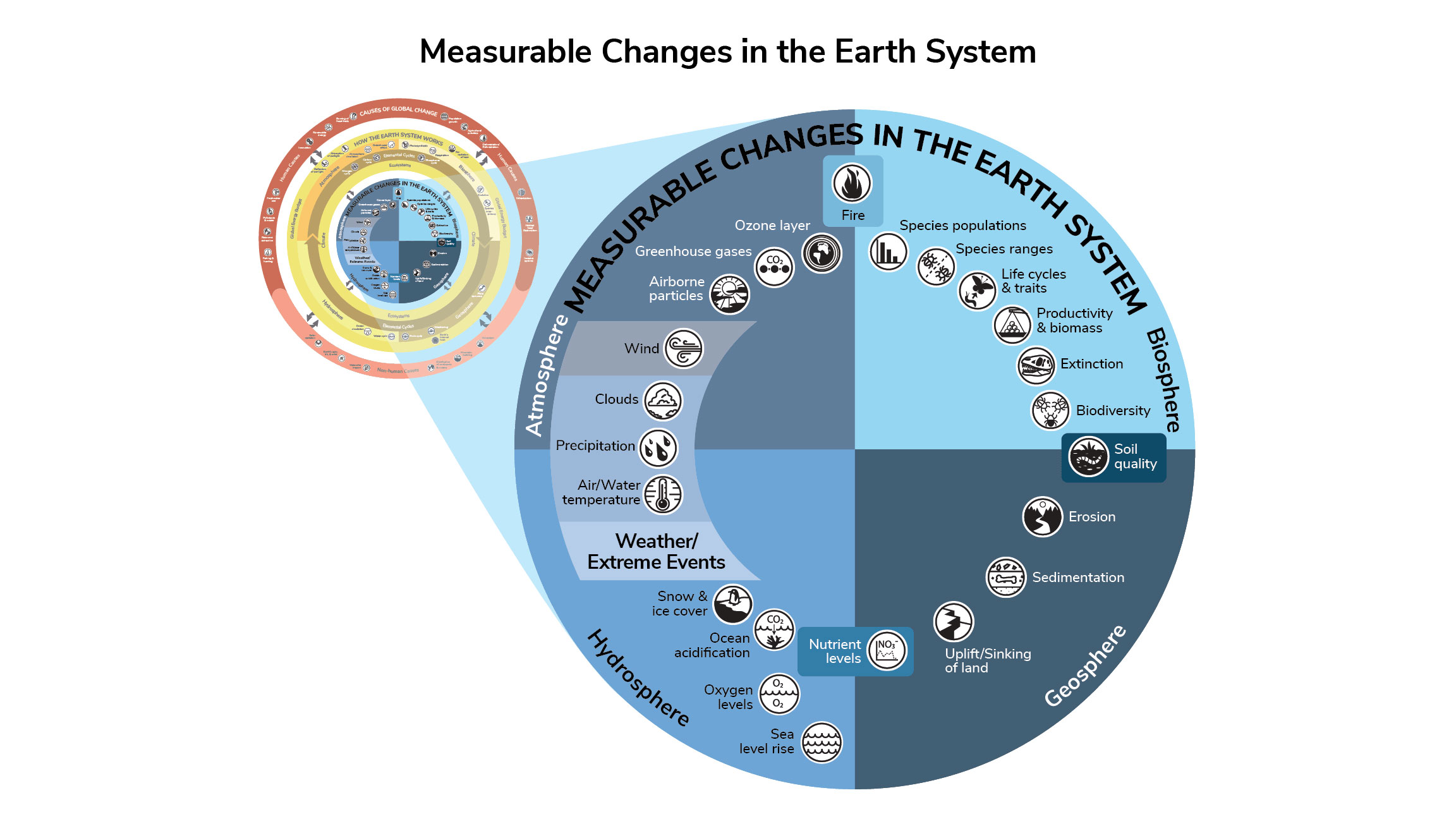
Human activities, especially land use practices and hunting and fishing, have dramatically impacted species populations (the number of individuals in a population) and species ranges (the geographic range over which a species is found). For example, wolves were once found in North America from the Arctic to Mexico (see map below). After the 1920s, wolves were no longer found in most of the lower 48 states due to habitat fragmentation and hunting, as the species was viewed as a threat to humans and livestock. In 1973, wolves became protected under the Endangered Species Act, and since then populations have stabilized. Species populations and ranges are influenced by interactions with other species. For example, the reintroduction of wolves to Yellowstone National Park has decreased elk populations, which were overgrazing the vegetation. Since the reintroduction of the wolves, this vegetation has recovered, providing food and habitat for other species, such as bison and beavers, which have become more abundant in the park.
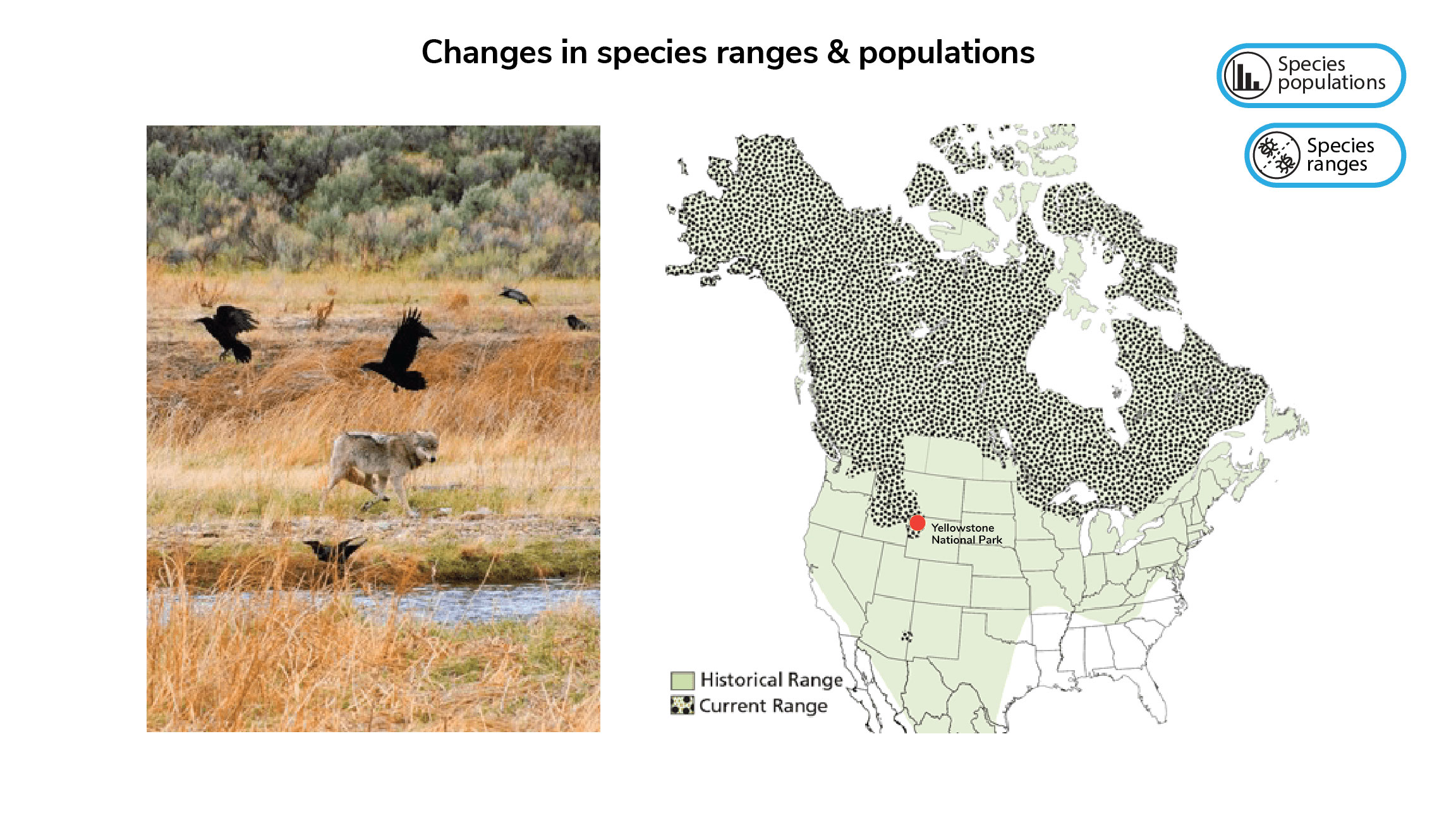
The effects of climate change can be measured by tracking shifts in the annual life cycles of plants and animals. These shifts include changes in the timing of growth and reproduction. For example, the date of the first blooms of flowering plants is often triggered by increasing temperatures with the onset of spring. As the Earth’s average temperature increases, many regions become warmer earlier in the year, causing plants to bloom days to weeks earlier than they used to (see orange and red dots on the map below). This can be problematic for plant species if their pollinators do not also arrive earlier. Note that because heat is redistributed by atmospheric circulation patterns, which change with global warming, some parts of the United States may actually experience a delayed onset of spring, causing later blooming times (see blue dots on the map below). These changes can be an issue for farmers trying to determine when to plant their crops or what species to grow.
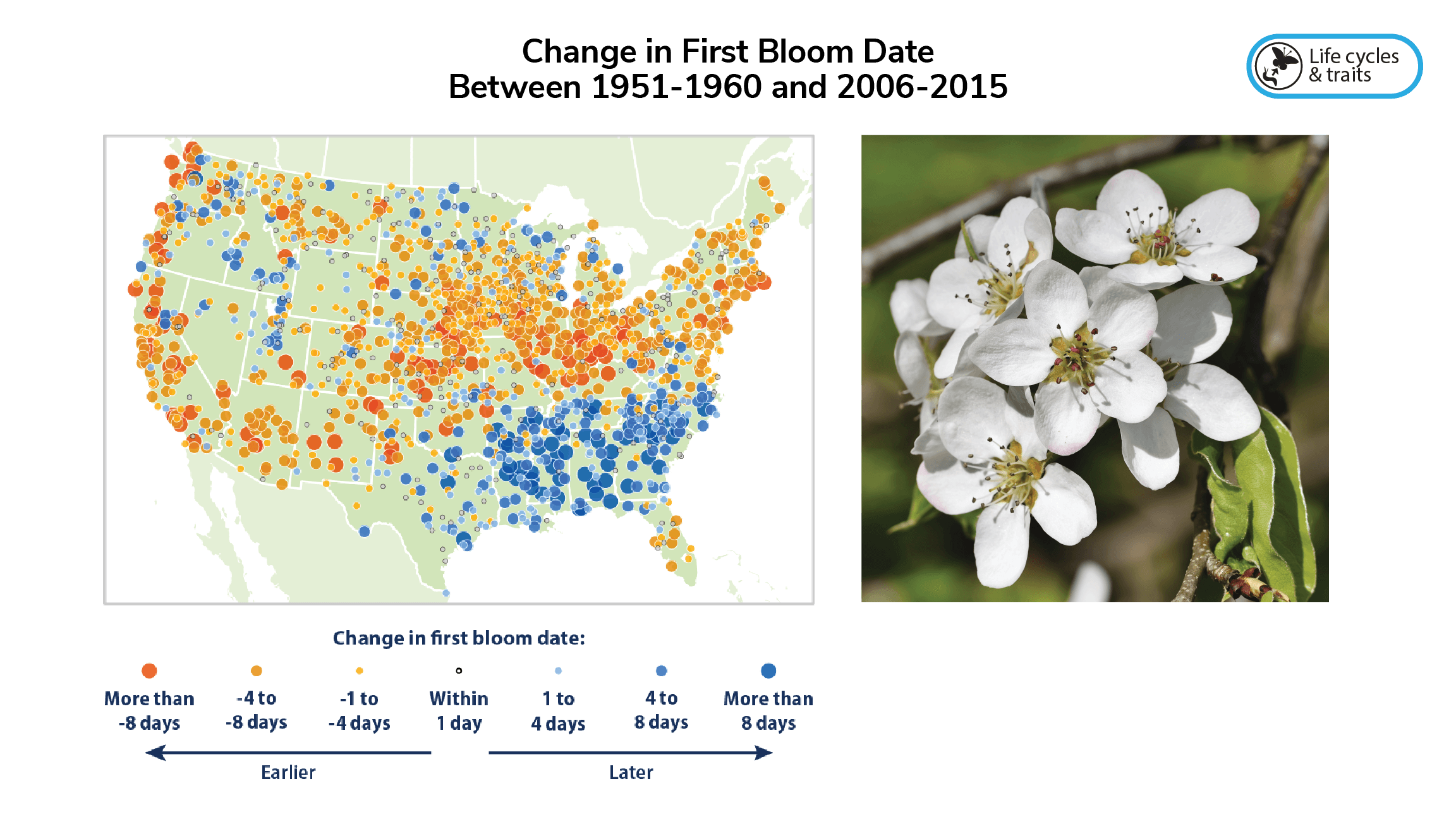
As humans, we affect and are affected by the Earth system in many ways. The quality of human life is inextricably tied to the condition of our planet. In the center of the Measurable Changes section of the diagram are changes that most directly affect our health and well-being, including the quality and availability of freshwater and food. Poor environmental conditions can cause displacement of human populations. Here we will briefly explore changes that affect the quality of human life.
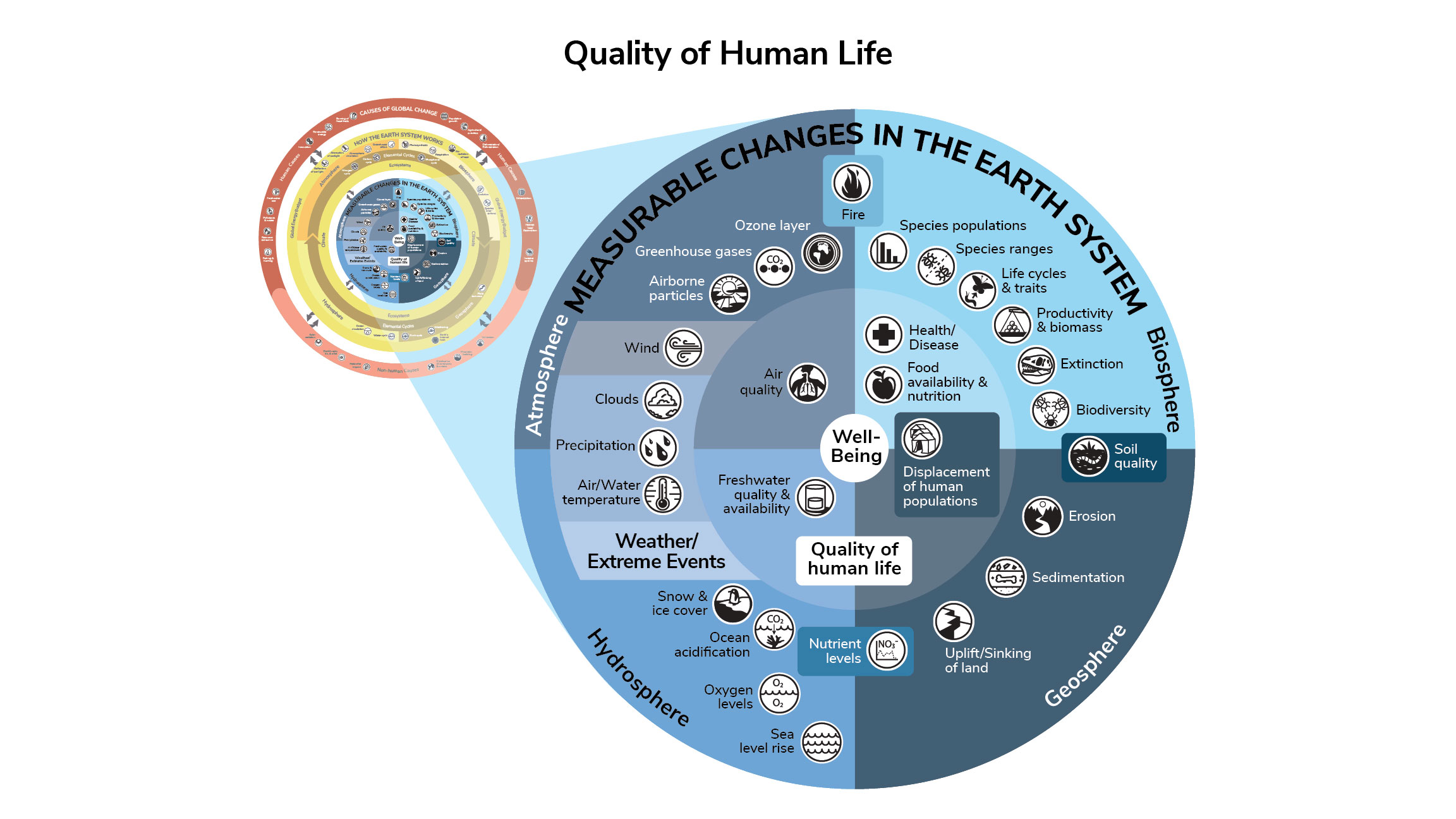
The quality of human life is dependent on the availability of clean freshwater for drinking, sanitation, and agriculture. Our water reserves come from ground water, lakes, and rivers, which are replenished through rainfall and snowmelt. Unfortunately, to meet the needs of growing populations, these reserves are being used faster than they are being replenished, which causes water stress (see map below). Climate change exacerbates water stress by increasing the frequency and duration of droughts.
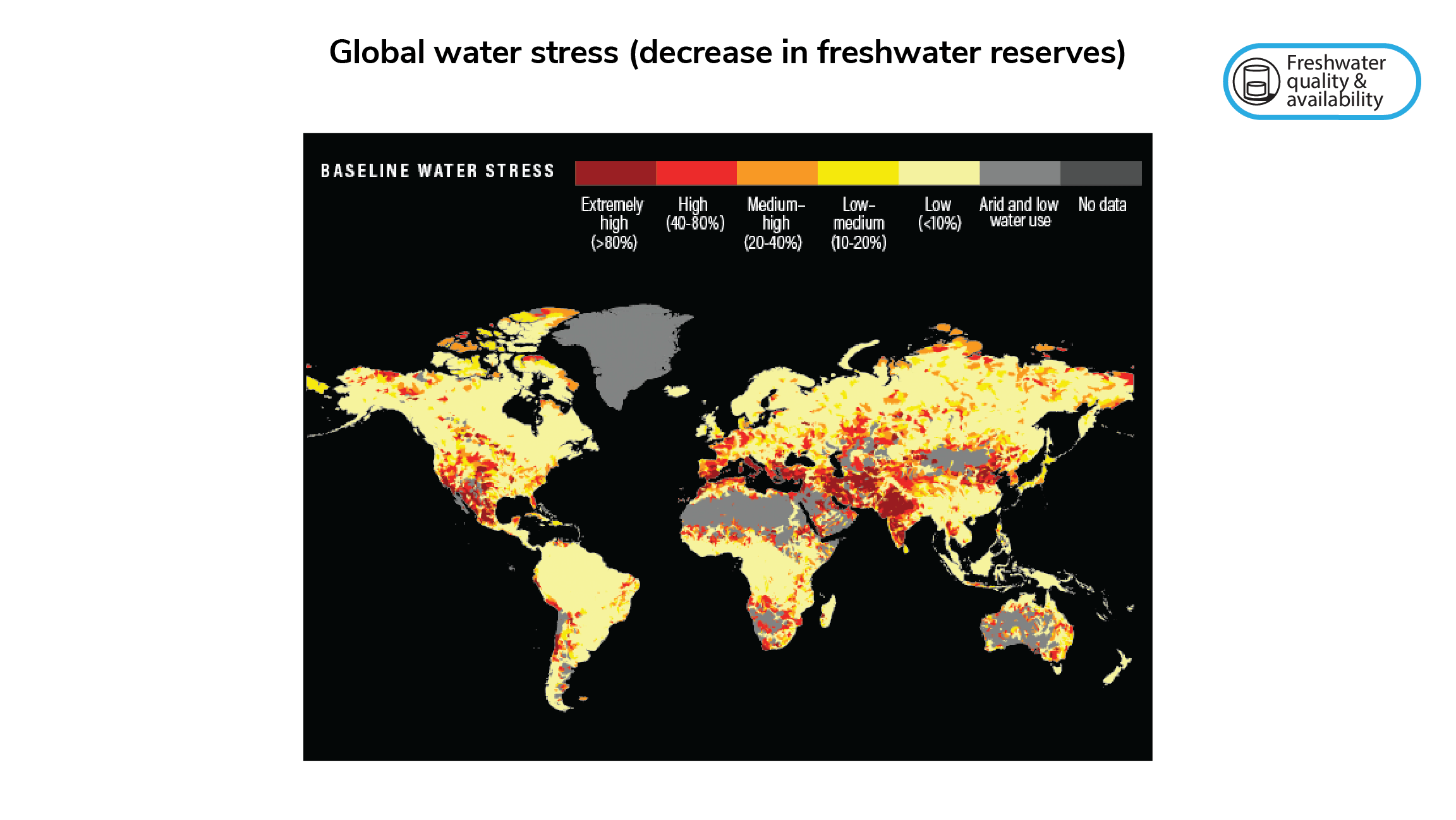
We have caused many changes to global ecosystems and climate at unprecedented scales and rates. We must consider how to use the Earth to maintain the resources necessary for the health of future generations. Through an understanding of how the Earth system works, we have the power to make decisions that can maintain and improve ecosystems, human health, and well-being across the globe.
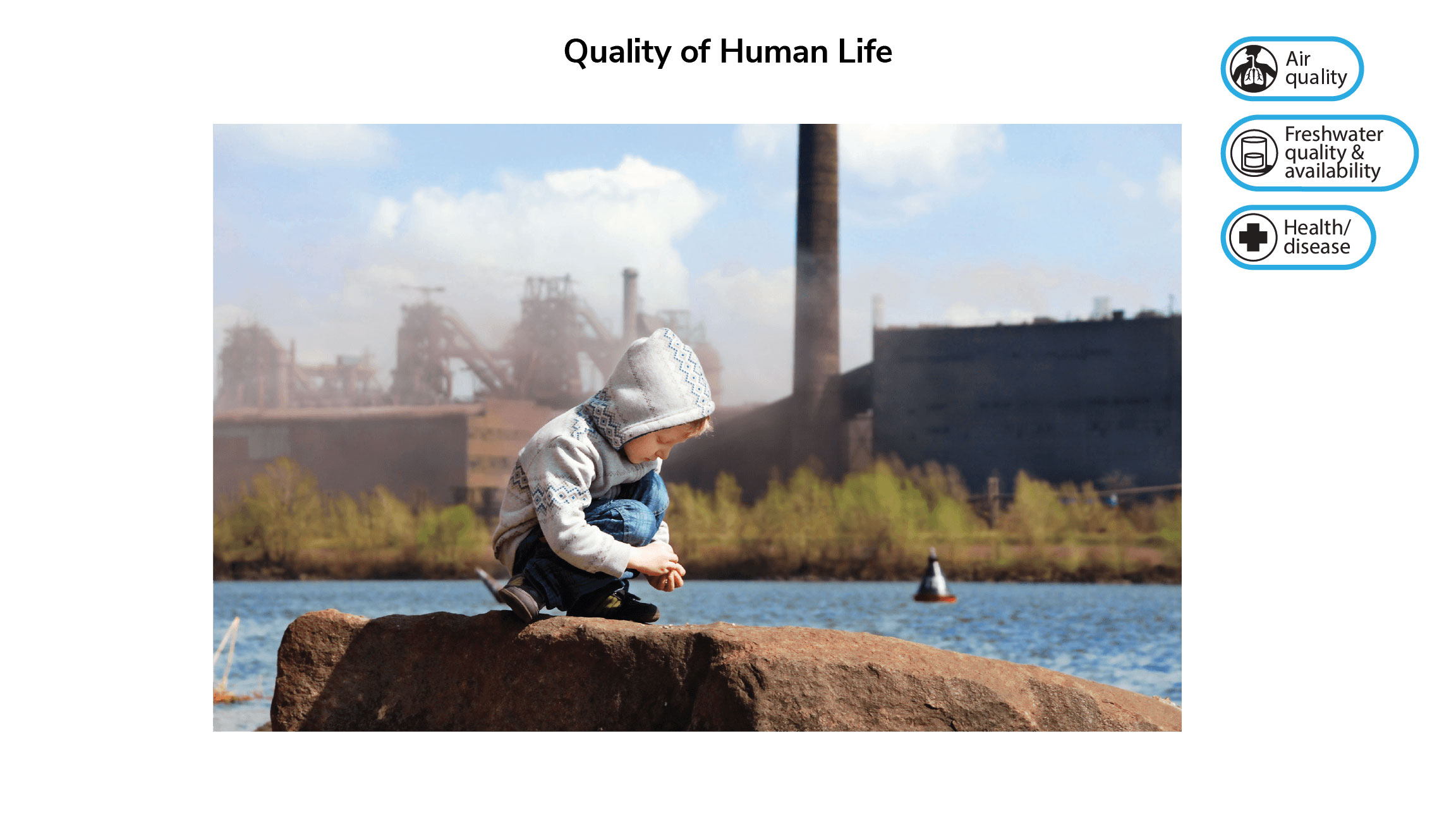
We have now completed our overview of the Understanding Global Change Framework, which provides a way to organize the many processes and phenomena that shape global climate and ecosystems. Please explore the Causes of Global Change, How the Earth System Works, and Measurable Changes in the Earth System pages to learn more about each of the topics in the framework. We live in a fascinating, complex, and interconnected world, and we hope that this resource helps you better understand how the Earth works.
